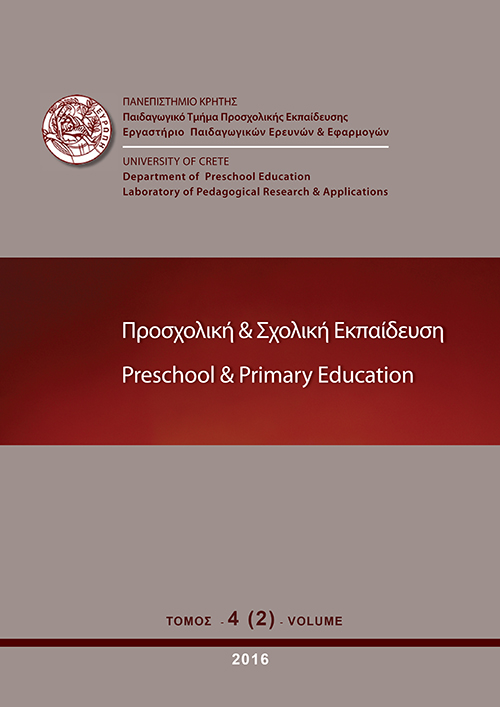Systematic Review of the Studies Examining the Impact of the Interactive Whiteboard on Teaching and Learning: what we do learn and what we do not
Περίληψη
This systematic review focuses on the impact of Interactive Whiteboards (IWBs) on teaching and learning. Learning is interpreted through a Vygotskian constructivist lens, emphasizing quality through dialogic interaction. Classroom interactions and achievement in standardized tests are considered formative and summative assessment tools, respectively. Thus, our aim was to investigate whether the IWB technology had any effect on teaching and learning, reflected in standardized forms of testing or in-classroom quality measures. An online search through Proquest and FirstSearch resulted in sixteen studies of diverse methodologies. Qualitative synthesis of quantitative data indicated that IWBs have not raised the levels of pupils’ achievement and do not necessarily impact the quality of classroom learning. More longitudinal studies should focus on particular subjects taught, the age of pupils and particular type(s) of use. Overall, quality teaching is an important condition for improved learning, which does not necessarily result from IWB use. However, there is a general consensus across all studies that learning can be facilitated and improved through the use of IWB. Synchronizing theory with technological applications seems to be key in answering such assumptions positively. More importantly, concerns are raised regarding the unfolded relation between achievement and classroom interaction.
Λεπτομέρειες άρθρου
- Πώς να δημιουργήσετε Αναφορές
-
Kyriakou, A., & Higgins, S. (2016). Systematic Review of the Studies Examining the Impact of the Interactive Whiteboard on Teaching and Learning: what we do learn and what we do not. Preschool and Primary Education, 4(2), 254–275. https://doi.org/10.12681/ppej.9873
- Τεύχος
- Τόμ. 4 Αρ. 2 (2016)
- Ενότητα
- Άρθρα

Αυτή η εργασία είναι αδειοδοτημένη υπό το CC Αναφορά Δημιουργού – Μη Εμπορική Χρήση – Παρόμοια Διανομή 4.0.
Οι συγγραφείς των άρθρων που δημοσιεύονται στο ΠΡΟΣΧΟΛΙΚΗ & ΣΧΟΛΙΚΗ ΕΚΠΑΙΔΕΥΣΗ διατηρούν τα δικαιώματα πνευματικής ιδιοκτησίας επί των άρθρων τους, δίνοντας στο περιοδικό το δικαίωμα της πρώτης δημοσίευσης. Άρθρα που δημοσιεύονται στο ΠΡΟΣΧΟΛΙΚΗ & ΣΧΟΛΙΚΗ ΕΚΠΑΙΔΕΥΣΗ διατίθενται με άδεια Creative Commons 3.0 και σύμφωνα με την άδεια μπορούν να χρησιμοποιούνται ελεύθερα, με αναφορά στο/στη συγγραφέα και στην πρώτη δημοσίευση για μη κερδοσκοπικούς σκοπούς και με δικαίωμα τροποποίησης μόνον με παρόμοια διανομή (αν αναμείξετε, τροποποιήσετε, ή δημιουργήσετε πάνω στο υλικό, πρέπει να διανείμετε τις δικές σας συνεισφορές υπό την ίδια άδεια όπως και το πρωτότυπο). To Εργαστήριο Παιδαγωγικών Ερευνών και Εφαρμογών του Παιδαγωγικού Τμήματος Προσχολικής Εκπαίδευσης του Πανεπιστημίου Κρήτης και το Εθνικό Κέντρο Τεκμηρίωσης διατηρούν το δικαίωμα να δημοσιεύουν, να αναπαραγάγουν, να παρουσιάζουν στο κοινό, να διανέμουν και χρησιμοποιούν άρθρα που δημοσιεύονται στο ΠΡΟΣΧΟΛΙΚΗ & ΣΧΟΛΙΚΗ ΕΚΠΑΙΔΕΥΣΗ σε οποιοδήποτε μέσο και μορφή είτε μεμονωμένα είτε ως μέρη συλλογικών έργων, για όλο το χρόνο διάρκειας προστασίας της πνευματικής ιδιοκτησίας και για όλες τις χώρες του κόσμου. Αυτό περιλαμβάνει ενδεικτικά και όχι αποκλειστικά, το δικαίωμα δημοσίευσης των άρθρων σε τεύχη του περιοδικού ΠΡΟΣΧΟΛΙΚΗ & ΣΧΟΛΙΚΗ ΕΚΠΑΙΔΕΥΣΗ, αναπαραγωγής και διανομής μεμονωμένων αντιγράφων των άρθρων, αναπαραγωγής ολόκληρων των άρθρων σε άλλη έκδοση του Εργαστηρίου Παιδαγωγικών Ερευνών και Εφαρμογών του Παιδαγωγικού Τμήματος Προσχολικής Εκπαίδευσης του Πανεπιστημίου Κρήτης και του Εθνικού Κέντρου Τεκμηρίωσης και αναπαραγωγής και διανομής των άρθρων ή περίληψης αυτών με χρήση πληροφορικού συστήματος αποθετηρίου.



